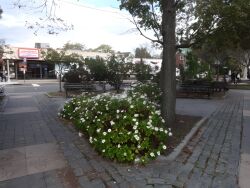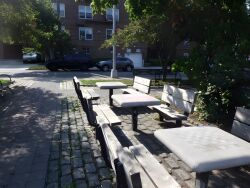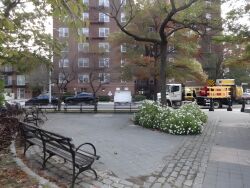Fleetwood Triangle
Fleetwood Triangle
Located in the Queens neighborhood of Rego Park, Fleetwood Triangle’s name takes its name from nearby Fleet Court and Woodhaven Boulevard, and boasts the butterfly as its park mascot.
Rego Park also bears a composite name, derived from the Real Good Construction Company, who in the 1920s developed the neighborhood. The area had previously been farmland and contained just one road running through it, Remsen’s Lane. This originally passed straight through Fleetwood triangle, bisecting the district, along the path of 63rd Drive, Fleet Court, and 64th Road. Many of the farmers were Chinese immigrants growing fruits and vegetables to sell in Chinatown.
In response to the City’s growing need for housing, the Real Good Construction Company bought up farm properties and marketed the area as a “REal GOod” place to raise a family, attracting residents with its new single-family row houses, apartment buildings, and multiple-family houses.
In 1928, a Long Island Railroad station opened nearby. Seven years later, the Long Island Expressway was extended to Queens, and by the end of 1936 subway service was established at Union Turnpike, making Rego Park a highly accessible neighborhood from every part of the region. Initially, Rego Park was heavily populated by Irish, German, and Italian immigrants. Since the 1970s, Rego Park has experienced an influx of immigrants from the former Soviet Union and Asia, particularly China.
Woodhaven Boulevard, Penelope Avenue, and 63rd Drive border Fleetwood Triangle. The City of New York acquired the site from a private landowner in 1920, so that the Department of Transportation could extend Penelope Avenue through Woodhaven Boulevard. Parks constructed Fleetwood Triangle in 1938 with granite blocks and plantings of English ivy (Hedera helix) and London planetree (Platanus orientalis).
The triangle is jointly operated by Parks and the Department of Transportation who, in 1997, completed a renovation of Fleetwood Triangle. The site now features benches, game tables, a flagpole with a yardarm, iron bollards, a compass with astrological signs, and butterfly block art.
Blooming within the triangle are butterfly weed (Asclepias tuberosa), purple coneflower (Echinacea purpurea), wild geranium (Geranium maculatum), creeping phlox (Phlox stolonifera), butterfly bush (Buddleia davidii), morrow honeysuckle (genus Lonicera), swamp azalea (Rhododendron viscosum), common lilac (Syringa vulgaris), Norway maples (Acer platanoides), thornless honey-locust (Gleditsia triacanthos), and sargent cherry (Prunus sargentii).
The shape of this triangle is like that of a butterfly wing, inspiring both the butterfly art, and the addition of new plantings that attract butterflies. Butterflies seek nectar, a nutrient of sugar starches, from shrubs and flowers. Butterflies are most attracted to species of Buttonbush (Cephalanthus occidentalis), New Jersey-tea (Ceanothus americanus), Joe-Pye weed (Eupatorium fistulosum), asters, phlox, and coreopsis.
Check out your park's Vital Signs
Clean & Safe
Green & Resilient
Empowered & Engaged Users
Share your feedback or learn more about how this park is part of a
Vital Park System



